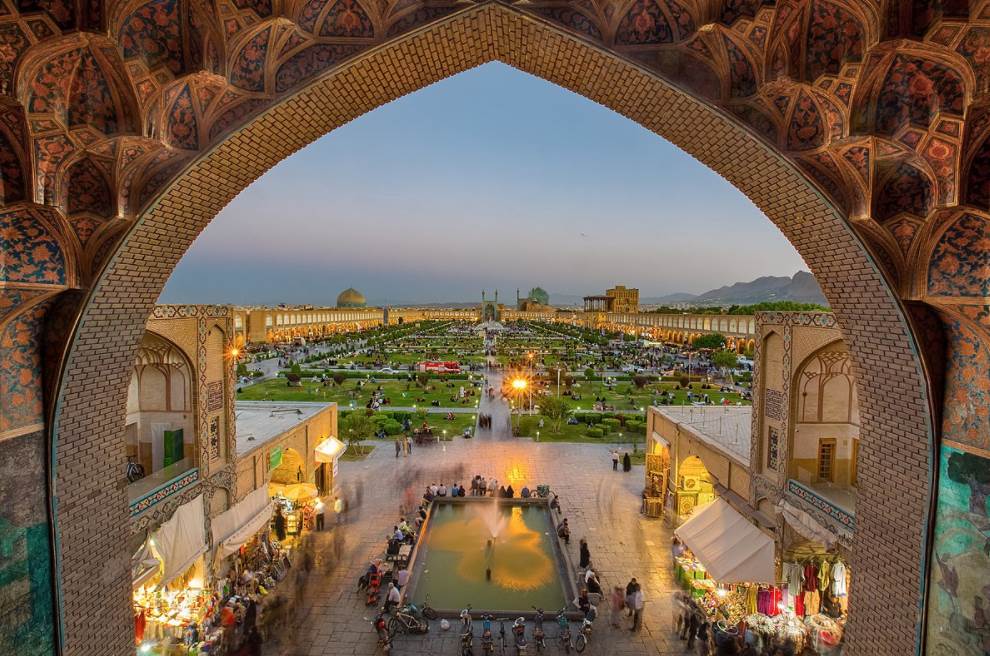One of the most stunning examples of Persian architecture can be found on the eastern side of one of the greatest squares in Isfahan, the third-most populous city in modern-day Iran.
In this article, you’ll discover the most interesting facts about Sheikh Lotfollah Mosque, a structure that features one of the most stunning domes in the world.
1. It’s the located on a famous square in the heart of Isfahan
Sheikh Lotfollah Mosque is located on the eastern side of one of the most amazing squares in the world known as Naqsh-e Jahan Square. This square is also sometimes referred to as “Saeed Square” or “Shah Square” and is a UNESCO World Heritage site.
This enormous public space in the center of Isfahan has dimensions of 160 (520 feet) by 560 meters (1,840 feet) and is surrounded by monuments that were built during the Persian Safavid Empire (1501-1736).
Some of these include the huge Shah Mosque, another masterpiece of Persian architecture, an Imperial Palace known as the Ali Qapu Palace, and the Qeysarie Gate on the northern side which leads into the Isfahan Grand Bazaar.
Another amazing landmark in the area, the Si O Se Pol Bridge that crosses the Zayandeh River, is located just southwest of this fascinating square.

2. The mosque was built when Isfahan was the capital of Persia
The square, the mosques, the monuments, and even the Si O Se Pol Bridge were constructed at the end of the 16th and beginning of the 17th century. They were commissioned by Abbas the Great (1571-1629), the 5th Shah of the Safavid Dynasty.
At the time that Abbas became the new ruler of Persia, Qazvin was its capital. He moved the capital from this city to Isfahan in the year 1598 and started an enormous building project.
Sheikh Lotfollah Mosque was the first of the 4 large monuments that dominate Naqsh-e Jahan Square, to be built. It was completed between 1603 and 1619, shortly after Isfahan became the Empire’s new capital.

3. The architectural design of the mosque is quite simple
Although this mosque is considered to be one of the most amazing examples of Persian architecture, its overall design is quite simple.
It doesn’t feature an outer courtyard and the building doesn’t feature internal spaces referred to as “iwans.” This means that the interior of the mosque pretty much consists of an entrance and a single space under a magnificent dome.
The dome rests on a square dome chamber and the L-shaped vestibule was integrated by architect Ostad Mohammad Reza Isfahani to ensure the direction towards Mecca was preserved.

4. The beauty of its decorations couldn’t be appreciated until centuries later
If you visit both the Shah Mosque and Sheikh Lotfollah Mosque then you’ll instantly notice several differences. The courtyards outside of the mosque are one thing, the fact that the latter doesn’t feature minarets is another.
The reason for this is that this particular mosque wasn’t commissioned by Abbas the Great to be open to the public. It was intended to serve as a private mosque, only intended to be visited by the royal court.
That’s why the overall architectural design of the structure was kept simple but the decorations of both the exterior and interior were made by the most skilled artists and are of the highest quality. The materials used to build the structure were of the highest quality as well.
Both Westerners and locals didn’t see the interior of this mosque until many centuries. The Shah could also enter the structure through a tunnel that ran below the square, straight to his Ali Qapu Palace.

5. Its main feature is an incredibly ornamented interior dome
The outer dome of the structure has a diameter of 22 meters (72 feet) and it reaches a maximum height of 32 meters (105 feet) above the ground. Both the exterior and interior of the dome are heavily ornamented with some of the most amazing calligraphy and tiles you’ll ever come across.
These were created by Master calligrapher Ali Reza Abbasi and are considered to be some of the finest Islamic decorations that were created in history up until that point.
The nads of decorations gradually become smaller, a feature that leads the viewer up into the apex of the dome. It’s one of those treasures of the world that become even more beautiful the longer you stare at it.

6. The mosque has had a couple of names throughout its history
The current name of the mosque refers to an inscription that was found inside the structure. This is a reference to Sheikh Lotfollah, an Imam that was paid by the Royal Household shortly after its completion. This also means that it was the first Imam to preach inside the mosque.
7. There’s something peculiar about the alignment of the dome
The L-shaped entrance hall was designed in such a way that the mosque is oriented in a correct position according to “qibla,” the direction towards the holy stone called the “Kaaba” in Mecca.
This resulted in a peculiar feature, especially considering the symmetrical decorations that cover the mosque. The dome of the mosque is not positioned directly behind the vestibule but is aligned slightly to its right.

8. The dome produces a remarkable optical illusion on sunny days
One of the most amazing facts about Sheikh Lotfollah Mosque in Isfahan is that visitors are welcomed with a remarkable view upon entering the main dome chamber of the structure.
On sunny days, as the sun shines through the apex of the dome, it produces a “peacock.” The sun rays that shine through this hole serve as the tail of this remarkable bird, quite a unique spectacle to behold!

source: art-facts.com
